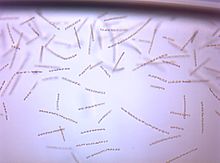Chaetocerotaceae
| Chaetocerotaceae | |
|---|---|

| |
| Chaetoceros furcellatus | |
| Scientific classification | |
| Domain: | Eukaryota |
| Clade: | Diaphoretickes |
| Clade: | SAR |
| Clade: | Stramenopiles |
| Phylum: | Gyrista |
| Subphylum: | Ochrophytina |
| Class: | Bacillariophyceae |
| Order: | incertae sedis |
| Family: | Chaetocerotaceae Ralfs in Pritchard 1861 |
| Genera[1] | |
| |
Chaetocerotaceae is a diatom family.[2] Chaetoceros is perhaps the largest and most species rich genus of marine planktonic diatoms. The taxonomic status within Chaetocerotaceae at present is somewhat unclear.[3]
Description
The cells have valves with long setae. Cells are often in unseparable chains, but may appear as solitary cells in some species. Chains are formed by fusion of silica between the setae. Endogenous resting spores are common and very different from normal vegetative cells.[2]
References
- ^ "Chaetocerotaceae Ralfs, 1861". WoRMS. World Register of Marine Species. 2024. Retrieved 7 May 2024.
- ^ a b Tomas, Carmelo R., ed. (1997). Identifying Marine Phytoplankton. Academic Press. ISBN 978-0-08-053442-8.
- ^ Rines, J.E.B.; Theriot, E.C. (2003). "Systematics of Chaetocerotaceae (Bacillariophyceae). I. A phylogenetic analysis of the family". Phycological Research. 51 (2): 83–98. doi:10.1046/j.1440-1835.2003.00297.x.

